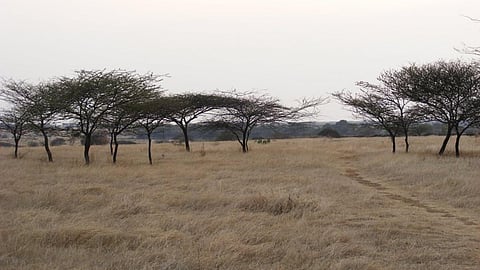
- Topics
- Feature
- Opportunities & Events
- About
- Hindi Portal
- Data
- Topics
- Feature
- Opportunities & Events
- About
- Hindi Portal
- Data

Vegetation in peninsular India is dominated by large tracts of grasslands, mainly savanna vegetation. However, this was not always so, argue the authors of this paper titled 'Monsoon forced evolution of savanna and the spread of agro‑pastoralism in peninsular India' in the journal Nature Scientific Reports. The area was dominated by moist deciduous forests earlier. So how did this happen?
Savanna vegetation includes grasslands that are formed by a continuous ground-layer of grasses interspersed with a woody layer of broadleaf or fine-leafed deciduous trees. It covers half of the surface of Africa and large areas of Australia, South America, and India.
Climate is the most important factor in creating a savanna, which grows in warm or hot climates where the annual rainfall is from about 50.8 to 127 cm (20-50 inches) per year. The climate favourable for the savannas includes rainfall that is concentrated in six or eight months of the year, followed by a long period of drought when fires can occur. The soil of the savanna is porous that helps to drain water, and has a thin layer of humus that provides nutrients.
The predominant vegetation in the savannas consists of grasses and forbs (small broad-leaved plants that grow with grasses). Different savannas support different grasses due to differences in rainfall and soil conditions. The savannas have a dry season and wet or rainy season. Most of the grasses are destroyed during the dry season either due to fires or lack of moisture and are again revived during the rainy season. Grasslands harbour a unique diversity with a range of plants and animals surviving in these harsh, but rich conditions.
The tropical savannas of India can be broadly classified into the following:
Read more on grasslands here
The paper argues that although evidence shows that grassland formation in India dates back to the late Miocene, some evidence reveals that the existing savannas of today in the subcontinent could be much younger.
This is because savannas of India have very few tree species that are only restricted to the savannas and secondly, many tree species of the moist and wet forests that are distributed between the moist Western Ghats of southern India and the Himalayas of North and East India are separated by extensive tracts of savanna vegetation.
Even though studies show that modern savannas in India are similar to natural savannas elsewhere in the world, questions continue to be raised on whether their formation has been influenced by Holocene climate fluctuations or the emergence of agro-pastoralism and use of fire in the region.
This has led to two lines of thought on the origin of the savannas – that human induced anthropogenic activities such as livestock-grazing, forest clearing and burning since the Neolithic led to a gradual degradation of deciduous forests to the savannas that we see today in India; or that changes in monsoonal moisture led to their formation and forced hunter-gatherer communities to practice agriculture to cope with diminishing food resources that also encouraged pastoralism in the process.
While it could be possible that humans in the hunter gatherer stage created savannas through burning, evidence points that such practices were already well-established in Late Pleistocene or Early Holocene times. Thus a direct linkage between the evolution of the savannas of peninsular India and Holocene climate change, fire and the emergence of agriculture cannot be proved as of now, argues the paper.
While no evidence exists from peninsular India for impact of anthropogenic influence on the landscape before the onset of the Neolithic/Chalcolithic period, the main influences during this period could have been related to localised activities such as clearing up of land for agricultural activities or grazing rather than large scale burning.
To find evidence for these arguments, the study used pollen and charcoal analysis by taking sediments from Lonar Meteorite Crater lake in peninsular India (a representative for the environmental history of the semi-arid south India) to explore the vegetation and climatic changes that might have influenced formation of savannas.
The analysis found that neither anthropogenic impact nor fire regime shifts, but monsoon weakening drove the expansion of savanna at the expense of forests in peninsular India.
Deciduous forests were present across peninsular India in the early Holocene and through the mid-Holocene. However, the weakening of the ISM began around the mid-Holocene, which forced forests to turn to savannas that spread and led to the modern day savannas of peninsular India. This savannisation might have created an attractive habitat for pastoralist immigrants, affected the food supply of hunter-gatherer communities and eventually triggered the transition to agriculture on the Deccan.
While the effect of increasing human impacts on the landscape also played some role in alteration in vegetation and creation of savannas in peninsular India, the study found that the origin of the savannas were strongly influenced by changes in rainfall patterns and decrease in rainfall in peninsular India, informs the paper.